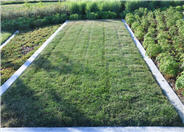
Common name:Kentucky Bluegrass
Botanical name:Poa pratensis
This is Kentucky Bluegrass, the ubiquitous turf grass covering much of the country, including the arid west. And while Kentucky bluegrass in general has a bad rap as a water-hoggish turf grass, it has two things going in its favor: nothing covers a playfield as efficiently or repairs as quickly as bluegrass; and two, a lot of research is taking place around Kentucky bluegrass and its kin to develop varieties that are slower growing, less water-needy, more salt tolerant, and generally better suited to the arid west. If you aren't using a space where it is planted, maybe give another palatte a thought, but at the least, water bluegrass as efficiently as possible following the guidelines provided to minimize over-watering and water waste.
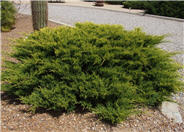
Common name:Scandia Juniper
Botanical name:Juniperus sabina 'Scandia'
'Scandia' juniper forms a densely branched evergreen groundcover with slightly horizontal branches, creating a layered appearance. It grows about 1 foot tall and up to 8 feet wide. It has soft green to yellow green foliage that holds its color all winter. Use as a groundcover, in a shrub border, or a rock garden.
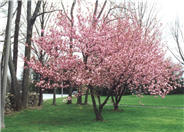
Common name:Kwanzan Flowering Cherry
Botanical name:Prunus serrulata 'Kwanzan'
'Kwanzan' is a lovely specimen that puts on an incredible early season show with clusters of large, double deep pink blooms, all the more lovely as new leaves amerge a bronzy-red. Foliage matures to a rich green. It has an upright, vase-shaped habit and reaches about 20 to 25 feet tall and 15 to 20 feet wide.
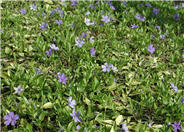
Common name:Dwarf Vinca or Periwinkle
Botanical name:Vinca minor
Periwinkle is a hardy, evergreen groundcover with glossy green leaves and cheery periwinkle blue or purple flowers in the spring. This plant is best suited to large areas and shrub borders, as it would overwhelm most perennials. Avoid its use along the riparian corridor or in urban/open space interfaces as it is aggressive and can escape, overtaking native plants. Easier to control in dry shade areas. Grows about 6 to 8 inches high, and spacing for planting purposes is about 2 to 3 feet, but its spread is indefinite.
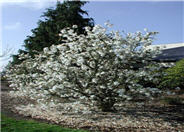
Common name:Star Magnolia
Botanical name:Magnolia stellata
Star magnolia is a deciduous tree with a spreading, rounded crown. Typically grows 15 to 20 feet tall with a similar spread. Often grown as a dense, multi-stemmed shrub. Fragrant, 12-18 petaled, white flowers which appear in early spring before the foliage emerges. Narrow-dark green leaves turn a brownish yellow in fall. Red seeds form in greenish pods which split open in fall. Common name is in reference to the star-like shape of the flowers.
| Designer: | Misc 56 |
Photographer: GardenSoft |
Water Saving Tip:
Change spray sprinklers to low-flow bubbler or drip systems. Shrubs and trees are ideal candidates for this type of irrigation because the water is applied directly to the root zones.
